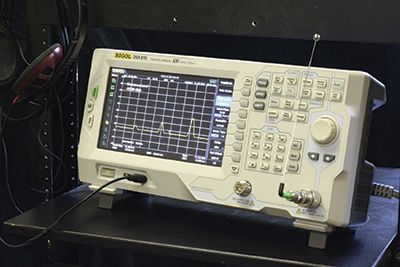

Try looking at it on a 10MHz span with a 10kHz RBW on both analysers and you should get a better idea of its true insertion loss. Also, I think you need to select a much narrower span if you want to see the (narrow) cavity response properly and this applies to both analysers. Also try turning down the RBW a bit as already suggested. You could also try the sample detector (best detector for noise) but on many analysers this can cause some subtle types of signal information to be lost if it is close to the noise floor. Most analysers would default to the normal detector as an all round compromise so maybe try again with this selected. The Rigol response looks to be about 20dB worse than this with the peak detector selected but you aren't supposed to use the peak detector to look at noise. The analysers I have here typically show a noise floor a few dB lower than this with the 10dB attenuator selected. 134dBm/Hz on a 1Hz noise marker) on a typical analyser. is memiliki standard kualitas - ISO9001:2000 Quality Management System - ISO14001:2004 Environmental Management System Rigol telah digunakan di lebih dari 60 negara di 6 benua, dengan kantor cabang di Cleveland, OH,and Munich, Germany Informasi lebih detail dapat di lihat di Untuk melihat penghargaan yang sudah diraih Rigol klik disini. Most analysers will have a noise figure of around 30dB with 0dB attenuation so the noise floor with a 1MHz RBW and 10dB atten selected should be about -74dBm (i.e. A couple of things to note: first, while the DSA815 and all other SA’s will display amplitude in a variety of units, the most useful is dBm, or dB referenced to 1 milliwatt. Many analysers offer a 'normal' detector, a positive peak detector, negative peak detector and a sample detector. In this case the SA’s input is one meter of wire acting as an antenna. I think the Rigol defaults to the peak detector algorithm in the DSP so the noise floor will look very high on the Rigol unless you choose a different detector in the menus. As you can see both show the peak at 150MHz but the Rigol doesn't show the negative peak afterwards (red arrow on the third picture) What do you think about? Rgds auato All the specifications apply to the following conditions unless otherwise noted.
#Noise floor of the rigol dsa815 generator#
10MHz to 12.5GHz -level 0dBm Of course I have just normalized the DSA815's tracking generator before. Specifications RIGOL Specifications for DSA800 Series 1 DSA815 Specifications This chapter lists the specifications and general specifications of the analyzer. Two spectrum analyzers are set in the same mode: -Center frequency 145MHz -Span 200MHz -Ref. The curves of the same cavity with the same cables are different. Yesterday I tried to check the response curve of a simple 145MHz cavity filter (first picture) by two different ways: 1) by my Rigol DSA815TG scalar network integrated system 2) by HP8595E spectrum analyzer + Wiltron 6621B programmable sweep generator (two instruments run independently so they are no syncronized Wiltron generator runs faster at 10ms of sweep and HP8959E has a slow sweep at 20 seconds - see the second picture).

I wish to get your attention for a strange behaviour about my Rigol DSA815TG just to know if my instrument have a trouble or I am forgotting something.


 0 kommentar(er)
0 kommentar(er)
